 Periodically we’ll feature one of our properties here to let our readers know about some great gay friendly places to stay:
Travel at the speed of you. Leave the tour buses behind. With The Blue Walk discover new places, have authentic experiences, and reconnect with a simpler way of moving through life. Enjoy leisurely, small-group, walking vacations along beautiful coastlines, village squares, and open spaces of Europe.
Less about history or architecture, our passion is sharing the sights and surroundings of select destinations. Live large on the French Riviera, tour Northern Italy via rail, island hop through Greece.
Discover the meditative quality of walking by large, lovely bodies of water, the expansiveness of taking in the canopy of blue sky. Take time on your own to explore an out of the way gem or sit quietly over a coastal outcrop. It’s your vacation. We create opportunities for unique experiences that touch the heart and mind to be remembered long after returning home.
No hiking boots or backpacks required, just lovely walking trails, coastal meandering, and urban strolling. Based in 4 and 5-star hotels, travel with a friendly group of like-minded people who soon become friends. Our vacations, perfect for couples, multi-generational, friends, and solo-travelers alike, are designed with lots of options to serve a variety of activity levels.
Periodically we’ll feature one of our properties here to let our readers know about some great gay friendly places to stay:
Travel at the speed of you. Leave the tour buses behind. With The Blue Walk discover new places, have authentic experiences, and reconnect with a simpler way of moving through life. Enjoy leisurely, small-group, walking vacations along beautiful coastlines, village squares, and open spaces of Europe.
Less about history or architecture, our passion is sharing the sights and surroundings of select destinations. Live large on the French Riviera, tour Northern Italy via rail, island hop through Greece.
Discover the meditative quality of walking by large, lovely bodies of water, the expansiveness of taking in the canopy of blue sky. Take time on your own to explore an out of the way gem or sit quietly over a coastal outcrop. It’s your vacation. We create opportunities for unique experiences that touch the heart and mind to be remembered long after returning home.
No hiking boots or backpacks required, just lovely walking trails, coastal meandering, and urban strolling. Based in 4 and 5-star hotels, travel with a friendly group of like-minded people who soon become friends. Our vacations, perfect for couples, multi-generational, friends, and solo-travelers alike, are designed with lots of options to serve a variety of activity levels.
France
Paris Gay Scene (NSFW)
 London, Tel Aviv, Madrid – we’ve explored some super hot gay scenes recently, and this week it’s Paris getting the Moovz treatment.
In this new video, cute local Sylvain Poisson meets the movers and shakers of the French capital’s queer community and the Paris Gay Scene.
The vid follows the presenter on a a wild night out. gay Parisian style. Watch as he takes in busy nightspots like Freedj Bar, Spirit of Star and the evidently very naughty Raidd Bar.
London, Tel Aviv, Madrid – we’ve explored some super hot gay scenes recently, and this week it’s Paris getting the Moovz treatment.
In this new video, cute local Sylvain Poisson meets the movers and shakers of the French capital’s queer community and the Paris Gay Scene.
The vid follows the presenter on a a wild night out. gay Parisian style. Watch as he takes in busy nightspots like Freedj Bar, Spirit of Star and the evidently very naughty Raidd Bar.
]]>
European Gay Ski Week 2017
 Nine years in the making. European Gay Ski Week 2017, the biggest and most spectacular “Gay Winter Sports and Music Festival” in Europe, will take place in Avoriaz in the picturesque French Alps, from March 11th-18th.
Nine years in the making. European Gay Ski Week 2017, the biggest and most spectacular “Gay Winter Sports and Music Festival” in Europe, will take place in Avoriaz in the picturesque French Alps, from March 11th-18th.
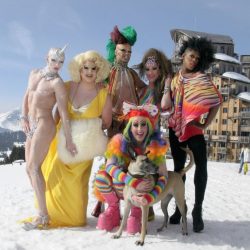 European Gay Ski Week is the first choice for gay and lesbian people from all over the world who want to experience the perfect Winter Holiday in a friendly and welcoming environment.
Enjoy a week of skiing, snowboarding, parties, great food and spas, signature party nights, Erotica, Snowball, Wig Party, and the Pool Party. EGSW 2017 is joined by international club brands such as Brut (London), BearDrop (Paris), Salvaje (Madrid), hosting nights of their own: their decks will feature the best DJ’s from all over the world.
Located in the heart of the Portes du Soleil, the biggest ski area in the world, Avoriaz resort is fully integrated into the surrounding areas, with snowy pedestrianised streets, horse-drawn sleigh taxis, and accommodations that have direct access to the slopes.
Make Your Reservations Here
European Gay Ski Week is the first choice for gay and lesbian people from all over the world who want to experience the perfect Winter Holiday in a friendly and welcoming environment.
Enjoy a week of skiing, snowboarding, parties, great food and spas, signature party nights, Erotica, Snowball, Wig Party, and the Pool Party. EGSW 2017 is joined by international club brands such as Brut (London), BearDrop (Paris), Salvaje (Madrid), hosting nights of their own: their decks will feature the best DJ’s from all over the world.
Located in the heart of the Portes du Soleil, the biggest ski area in the world, Avoriaz resort is fully integrated into the surrounding areas, with snowy pedestrianised streets, horse-drawn sleigh taxis, and accommodations that have direct access to the slopes.
Make Your Reservations Here
Southeastern France Gay Travel Resources
]]>
Villa Loca B&B – Gay, Clothing Optional B&B in Puechabon, France
 Periodically we’ll feature one of our properties here to let our readers know about some great gay friendly places to stay:
Eric and Patrice will reiceive you in Puechabon, typical Languedoc village located 25 minutes from Montpellier, close to the gorges of the Herault and only 45 minutes from the Mediterranean.
We offer you two spacious guest rooms of about 35 m2 each equipped kitchenettes, and private bathroom and three other bedrooms of 20 m2 each equipped with their own bathroom and private WC.
You can enjoy the hammam, the large swimming pool (12 X 5) including a hot tub, or relax in another jacuzzi lulled by the chirping of cicadas.
The wooded and wild environment, without any opposite, leads to naturism .
Breakfasts will be served on the terrace of the house.
Puechabon adjoins the trusted Gorges de l’ Herault and you will discover a diverse and unique heritage as the village of Saint Guilhem le Desert and the Devil’s Bridge ( World Heritage of UNESCO), Clamouse cave, Salagou Lake. You can pracitce hiking, biking, canoeing, via ferrata ….
Periodically we’ll feature one of our properties here to let our readers know about some great gay friendly places to stay:
Eric and Patrice will reiceive you in Puechabon, typical Languedoc village located 25 minutes from Montpellier, close to the gorges of the Herault and only 45 minutes from the Mediterranean.
We offer you two spacious guest rooms of about 35 m2 each equipped kitchenettes, and private bathroom and three other bedrooms of 20 m2 each equipped with their own bathroom and private WC.
You can enjoy the hammam, the large swimming pool (12 X 5) including a hot tub, or relax in another jacuzzi lulled by the chirping of cicadas.
The wooded and wild environment, without any opposite, leads to naturism .
Breakfasts will be served on the terrace of the house.
Puechabon adjoins the trusted Gorges de l’ Herault and you will discover a diverse and unique heritage as the village of Saint Guilhem le Desert and the Devil’s Bridge ( World Heritage of UNESCO), Clamouse cave, Salagou Lake. You can pracitce hiking, biking, canoeing, via ferrata ….
See the Villa Loca B&B Expanded Listing on Purple Roofs Here
Gay Friendly Bed and Breakfasts, Hotels, and Vacation Rentals in Languedoc, France
]]>
Relive Hollywood in Paris
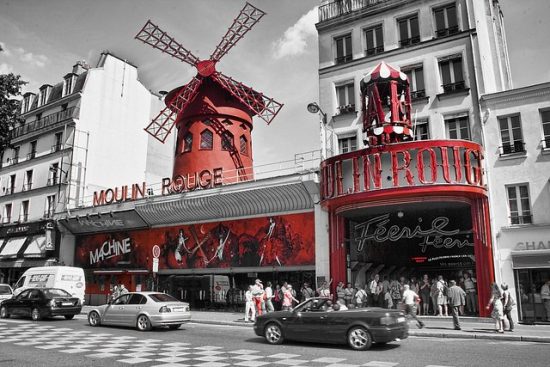 Image via Flickr by Gabriel Villena Fernandez
Image via Flickr by Gabriel Villena Fernandez
[/caption]
“Paris is always a good idea,” said Audrey Hepburn, a Hollywood legend who acted in romantic movies that featured famous landmarks in Paris. With so many great motion pictures made in this European city, it’s no wonder it earns these three nicknames: The City of Love, The City of Romance, and The City of Lights.
Let’s traverse the romantic lanes in Paris and get a glimpse of the landmarks that grace it.
Moulin Rouge
Gone are the days of French courtesans in the city of Paris, but Moulin Rouge on Boulevard de Clichy is still alive with the “can-can” dance which the nation invented. Nicole Kidman and Ewan McGregor made this area more popular in the film with the same name. Watch a show or two and relive the past through glamorous cabaret performances.
By Alain – Full Story at Keep Calm and Wander
]]>
Gay Paris: A Great City
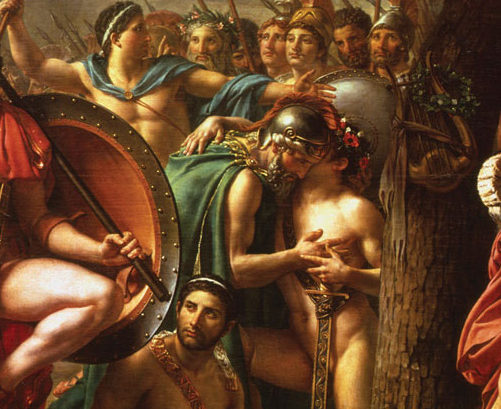 Gay Paris is of course one of the world’s greatest cities–above all, one of its great cultural cities, with literature and art and architecture and fashion and cuisine and so on and so forth. But I think that Americans easily forget how great a gay city it is as well. They don’t call it “Gay Paris” for nothing!
Among other things, I think few people know that France eliminated its laws against sodomy in 1791, 212 years before the US Supreme court decided Lawrence v. Texas. This is why (or part of why) so many American and English gay people, such as Oscar Wilde or James Baldwin, went to live in Paris in the 19th and 20th centuries.
But Paris generally has an amazing gay tradition, and the list of gay greats who have lived there is endless, including Frenchmen such as Proust, Jean Cocteau, Genet, and Yves Saint Laurent and expats from many lands, such as Diaghilev, Nijinsky, and Cole Porter. It has a particularly fascinating Lesbian history, with Lesbian greats both French, such as Colette, and American, such as Gertrude Stein and Alice Toklas.
So…just as is true with New York and London and Berlin, a gay history tour is a great way to visit gay Paris. In fact, gay history is such an important theme in Parisian history that it leads you to and through the main neighborhoods and museums, showing you a fascinating and relatable side of the city that a normal tour or guidebook would simply ignore.
Gay Paris is of course one of the world’s greatest cities–above all, one of its great cultural cities, with literature and art and architecture and fashion and cuisine and so on and so forth. But I think that Americans easily forget how great a gay city it is as well. They don’t call it “Gay Paris” for nothing!
Among other things, I think few people know that France eliminated its laws against sodomy in 1791, 212 years before the US Supreme court decided Lawrence v. Texas. This is why (or part of why) so many American and English gay people, such as Oscar Wilde or James Baldwin, went to live in Paris in the 19th and 20th centuries.
But Paris generally has an amazing gay tradition, and the list of gay greats who have lived there is endless, including Frenchmen such as Proust, Jean Cocteau, Genet, and Yves Saint Laurent and expats from many lands, such as Diaghilev, Nijinsky, and Cole Porter. It has a particularly fascinating Lesbian history, with Lesbian greats both French, such as Colette, and American, such as Gertrude Stein and Alice Toklas.
So…just as is true with New York and London and Berlin, a gay history tour is a great way to visit gay Paris. In fact, gay history is such an important theme in Parisian history that it leads you to and through the main neighborhoods and museums, showing you a fascinating and relatable side of the city that a normal tour or guidebook would simply ignore.
Great Gay Paris Tombs
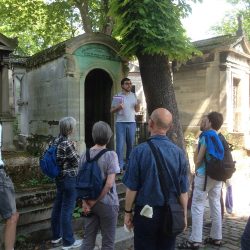 Two of the best places for a gay history tour in Paris are the great monumental cemetery, Père Lachaise, and the Louvre Museum. Any guidebook will tell you that Oscar Wilde is buried in Père Lachaise, and many will also mention Gertrude Stein (along of course with many famous straight people, such as Chopin or Edith Piaf). But there are so many more tombs of famous gay and Lesbian people, including Proust and Colette.
One of the things that I find most fascinating is the long history of gay couples buried together or close to each other—starting in the Napoleonic period. The tomb in this picture is an interesting example, or possible example: it contains the remains of two Napoleonic generals, Louis Lemoine and Jean-Pierre Augereau.
Both died relatively late; neither ever married. The inscription says, “here lie two ancient warriors, two friends, death separated them, death reunites them, glory is eternal, and friendship ends.” A couple? Impossible to say, of course—but given the reticence of the past and the suppression of evidence, that is typical of gay history. An interesting mystery, in any case. In the photo, you see one of my gay history walking tours.
Two of the best places for a gay history tour in Paris are the great monumental cemetery, Père Lachaise, and the Louvre Museum. Any guidebook will tell you that Oscar Wilde is buried in Père Lachaise, and many will also mention Gertrude Stein (along of course with many famous straight people, such as Chopin or Edith Piaf). But there are so many more tombs of famous gay and Lesbian people, including Proust and Colette.
One of the things that I find most fascinating is the long history of gay couples buried together or close to each other—starting in the Napoleonic period. The tomb in this picture is an interesting example, or possible example: it contains the remains of two Napoleonic generals, Louis Lemoine and Jean-Pierre Augereau.
Both died relatively late; neither ever married. The inscription says, “here lie two ancient warriors, two friends, death separated them, death reunites them, glory is eternal, and friendship ends.” A couple? Impossible to say, of course—but given the reticence of the past and the suppression of evidence, that is typical of gay history. An interesting mystery, in any case. In the photo, you see one of my gay history walking tours.
Great Gay Paris Art
 The Louvre is also an amazing place to look for gay history. In part, this is because it has such a great Greek and Roman collection—often the gayest part of any museum’s collection. But the Louvre’s ancient collections are particularly gay, from a little bronze plaque representing an initiation ritual (like so many initiation rituals, involving male-male sex) on pre-Classical Crete to a lavish collection of male-male courtship scenes in vase-paintings, to halls full of homoerotic Greek male nudes, to not one but four statues or busts of the Emperor Hadrian’s boyfriend Antinous, whom the Emperor declared a god after his death (suicide?) at the age of 19. There are over 100 ancient representations of Antinous left in the world, and most major museums have one. But four? Only the Louvre.
The Renaissance Italian collection is also particularly homoerotic, including one major homoerotic work by each of those gay superheroes, Michelangelo and Leonardo. Leonardo’s is his surprisingly dishy St. John the Baptist, who appears more like a young pagan god than an ascetic saint and seems to have been modeled on a curly-haired young assistant with whom Leonardo was in love, Gian Giacomo Caprotti, better known by Leonardo’s nickname for him, Salaì (more or less ‘little devil’). Of course the Louvre also contains the Mona Lisa, which many art historians also believe was modeled on Salaì as well.
Michelangelo is represented by what is probably his most homoerotic work, the so-called Dying Slave: a languid and effeminate male nude who seems not to be dying but to be in ecstasy. Michelangelo has drawn here on the tradition of that most homoerotic saint, Saint Sebastian, and possibly also on his feelings about own erotic life, as he refers to himself in one of the sonnets addressed to his great love, Tommaso de’ Cavalieri, as a conquered, chained, and naked prisoner of a knight (with a pun on the name ‘Cavalieri’).
The Louvre is also an amazing place to look for gay history. In part, this is because it has such a great Greek and Roman collection—often the gayest part of any museum’s collection. But the Louvre’s ancient collections are particularly gay, from a little bronze plaque representing an initiation ritual (like so many initiation rituals, involving male-male sex) on pre-Classical Crete to a lavish collection of male-male courtship scenes in vase-paintings, to halls full of homoerotic Greek male nudes, to not one but four statues or busts of the Emperor Hadrian’s boyfriend Antinous, whom the Emperor declared a god after his death (suicide?) at the age of 19. There are over 100 ancient representations of Antinous left in the world, and most major museums have one. But four? Only the Louvre.
The Renaissance Italian collection is also particularly homoerotic, including one major homoerotic work by each of those gay superheroes, Michelangelo and Leonardo. Leonardo’s is his surprisingly dishy St. John the Baptist, who appears more like a young pagan god than an ascetic saint and seems to have been modeled on a curly-haired young assistant with whom Leonardo was in love, Gian Giacomo Caprotti, better known by Leonardo’s nickname for him, Salaì (more or less ‘little devil’). Of course the Louvre also contains the Mona Lisa, which many art historians also believe was modeled on Salaì as well.
Michelangelo is represented by what is probably his most homoerotic work, the so-called Dying Slave: a languid and effeminate male nude who seems not to be dying but to be in ecstasy. Michelangelo has drawn here on the tradition of that most homoerotic saint, Saint Sebastian, and possibly also on his feelings about own erotic life, as he refers to himself in one of the sonnets addressed to his great love, Tommaso de’ Cavalieri, as a conquered, chained, and naked prisoner of a knight (with a pun on the name ‘Cavalieri’).
Gay Spartans
And there is much much more. Again, as at the cemetery, the Napoleonic period provides a surprising amount of gay material. For instance, in a vast canvas representing the Spartans in the pass at Thermopylae, just to the side of the naked leader Leonidas, David places a little citation of ancient Greek sexuality, a naked adolescent boy snuggling up to his bearded lover (see featured image). This is just what probably took place in the pass at Thermopylae. Even among Greeks, the Spartans were famous for their male-male relations, and many Greek writers associated this kind of relationship with courage (on the theory, very different from a modern idea of homosexuality, that no-one would do anything cowardly in front of his male lover). But it is very rare for a modern representation of ancient Greece to represent such a scene explicitly. In fact, I have listened to what French guides say about the painting, and they always say that it is a son with his father—but *no* Greek source says anything about sons and fathers encouraging each other to be courageous in battle, so that is just a modern bowdlerization. The Louvre, in short, is one of the greatest gay museums. And there is lots of gay stuff to see elsewhere in Paris too!
To learn more, come on one of Oscar Wilde Tours’ gay Paris tours. We are doing a combined tour of gay history and art (with of course lovely hotels, great food etc.) in Paris and London (which if anything is even gayer!) August 20-28, and we are now offering a $400 discount on remaining seats! Check it out at: http://www.oscarwildetours.com/gay-londongay-paris/ (Either half of the tour can be purchased separately, with a $200 discount)
The Louvre, in short, is one of the greatest gay museums. And there is lots of gay stuff to see elsewhere in Paris too!
To learn more, come on one of Oscar Wilde Tours’ gay Paris tours. We are doing a combined tour of gay history and art (with of course lovely hotels, great food etc.) in Paris and London (which if anything is even gayer!) August 20-28, and we are now offering a $400 discount on remaining seats! Check it out at: http://www.oscarwildetours.com/gay-londongay-paris/ (Either half of the tour can be purchased separately, with a $200 discount)
]]>
France's First Gay Carnival – Nomadic Boys
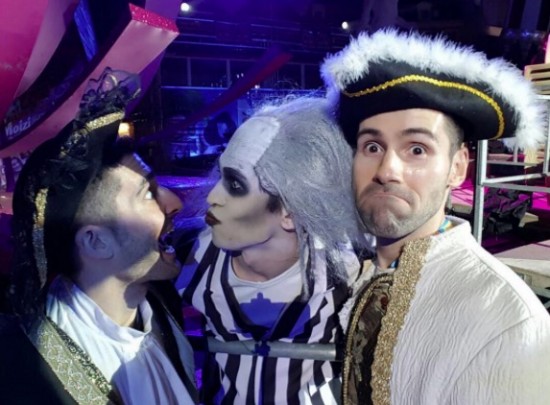
 Feather boas…glitter…cray cray make up…sexy topless men… This is Lou Queernaval, France’s first gay carnival and part of the famous Nice Carnival.
We spent 3 days dancing and partying through the streets of the city celebrating Lou Queernaval clad in our medieval outfits.
The carnival originated in the Middle Ages as a festival authorised by the church, allowing anyone wearing a mask to safely ridicule those in power. Anyone without a mask got flogged with stockings filled with flour. This is the time of year when Christians go crazy with overindulgence, eat loads of meat, fatty foods and party like mad before the 40 days of fasting for Lent begins.
Feather boas…glitter…cray cray make up…sexy topless men… This is Lou Queernaval, France’s first gay carnival and part of the famous Nice Carnival.
We spent 3 days dancing and partying through the streets of the city celebrating Lou Queernaval clad in our medieval outfits.
The carnival originated in the Middle Ages as a festival authorised by the church, allowing anyone wearing a mask to safely ridicule those in power. Anyone without a mask got flogged with stockings filled with flour. This is the time of year when Christians go crazy with overindulgence, eat loads of meat, fatty foods and party like mad before the 40 days of fasting for Lent begins.
By Stefan Arestis – Full Story at the Nomadic Boys
Southeastern France Gay Travel Resources
]]>
Fountainebleau – The Paris Day Trip You Must Take
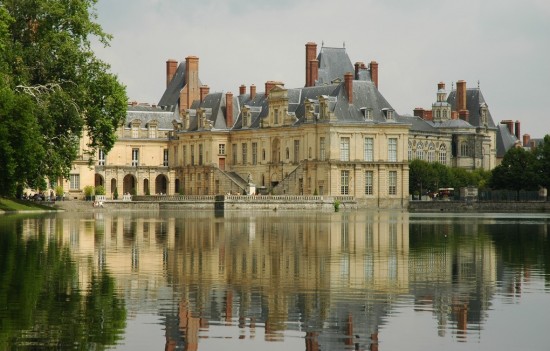 Due to popular demand we’ve added one more Paris-related article to our recent series on the City of Light. This one is a day trip to Fontainebleau, our favorite nearby castle besides Versailles. In some ways, visiting Versailles during your trip to Paris has become so commonplace it borders on cliche. It’s not so much a day-trip as an extension of the city itself; as important to your Parisian cultural experience as a day at the Louvre, or a walk along the Seine.
In other words, you don’t need us to tell you to visit Versailles, just as you don’t need us to hold your hand on the way to the Eiffel Tower. But we thought you should know, there are other fish in the sea, and the Chateau Fontainebleau is one of our favorites. It’s not as well known, which also means it’s a bit less expensive and not as overrun with tourists and easy to get to; the palace is 34 miles southeast of Paris and accessible by train. The palace is, however, every bit as fabulous as Versailles, with a rich and longer history all its own.
Fountainebleau, a convenient day trip from Paris in Towleroad and in ManAboutWorld gay travel magazineBuilt in the 12th century, it was first used as a hunting lodge for the Kings of France (specifically Louis VII and Louis IX) and later expanded in the 16th century by King Henry II, and again by Henry IV. It is the birthplace and burial grounds of many French kings and has survived nearly a thousand years of revolutions and conflicts, remaining one of the world’s grandest estates.
Due to popular demand we’ve added one more Paris-related article to our recent series on the City of Light. This one is a day trip to Fontainebleau, our favorite nearby castle besides Versailles. In some ways, visiting Versailles during your trip to Paris has become so commonplace it borders on cliche. It’s not so much a day-trip as an extension of the city itself; as important to your Parisian cultural experience as a day at the Louvre, or a walk along the Seine.
In other words, you don’t need us to tell you to visit Versailles, just as you don’t need us to hold your hand on the way to the Eiffel Tower. But we thought you should know, there are other fish in the sea, and the Chateau Fontainebleau is one of our favorites. It’s not as well known, which also means it’s a bit less expensive and not as overrun with tourists and easy to get to; the palace is 34 miles southeast of Paris and accessible by train. The palace is, however, every bit as fabulous as Versailles, with a rich and longer history all its own.
Fountainebleau, a convenient day trip from Paris in Towleroad and in ManAboutWorld gay travel magazineBuilt in the 12th century, it was first used as a hunting lodge for the Kings of France (specifically Louis VII and Louis IX) and later expanded in the 16th century by King Henry II, and again by Henry IV. It is the birthplace and burial grounds of many French kings and has survived nearly a thousand years of revolutions and conflicts, remaining one of the world’s grandest estates.
By Ed Salvato – Full Story at Towleroad.com
Mediterranean Wonders in France and Spain
 I’ve traversed the European continent more times than I can count, yet somehow Spain’s marvels had managed to elude me all these decades. Iberia has long been first on my bucket list and the prospect of an 11-day cruise hugging Spain’s Mediterranean coast, with Nice and Gibraltar as beguiling bookends, was the perfect way to finally take in the renowned Alhambra, Calatrava’s bridges, the staccato strains of Flamenco, platters of seafood paella, Seville’s magnificent Alcazar, and, what I’ve been longing for years to see, Gaudi’s fantastic architectural wonders.
My previous cruise experiences were limited to river boats with 50-60 cabins, so initially I had qualms about larger ships, but the 500-passenger Azamara Quest (www.azamara.com) proved the perfect way to test the waters. Special touches emblematic of a luxury line were in ample evidence: exemplary service, bottled water at the gangplank, excellent wines paired at dinner, meals served on your schedule and in perfectly sized portions, so you still look forward to a dessert of vanilla creme brulee with raspberries. Yet, as classy as the Azamara Quest was, its ambiance remained friendly and casual, perfect for those like myself who prefer to leave the formal jacket at home.
Aboard the Quest, my friend Rob and I unpacked and stowed our suitcases in our 175-square-foot Club Veranda Stateroom, replete with comfortable furnishings and handy extras like a pair of binoculars, fresh-cut alstroemerias, and complimentary shoe shine. The self-service laundry room down the hall proves crucial to those on longer voyages. Paying extra to enjoy the passing view through the sliding glass doors is well worth it, and we loved eating breakfast on our veranda and sleeping with the door open on warm nights.
I’ve traversed the European continent more times than I can count, yet somehow Spain’s marvels had managed to elude me all these decades. Iberia has long been first on my bucket list and the prospect of an 11-day cruise hugging Spain’s Mediterranean coast, with Nice and Gibraltar as beguiling bookends, was the perfect way to finally take in the renowned Alhambra, Calatrava’s bridges, the staccato strains of Flamenco, platters of seafood paella, Seville’s magnificent Alcazar, and, what I’ve been longing for years to see, Gaudi’s fantastic architectural wonders.
My previous cruise experiences were limited to river boats with 50-60 cabins, so initially I had qualms about larger ships, but the 500-passenger Azamara Quest (www.azamara.com) proved the perfect way to test the waters. Special touches emblematic of a luxury line were in ample evidence: exemplary service, bottled water at the gangplank, excellent wines paired at dinner, meals served on your schedule and in perfectly sized portions, so you still look forward to a dessert of vanilla creme brulee with raspberries. Yet, as classy as the Azamara Quest was, its ambiance remained friendly and casual, perfect for those like myself who prefer to leave the formal jacket at home.
Aboard the Quest, my friend Rob and I unpacked and stowed our suitcases in our 175-square-foot Club Veranda Stateroom, replete with comfortable furnishings and handy extras like a pair of binoculars, fresh-cut alstroemerias, and complimentary shoe shine. The self-service laundry room down the hall proves crucial to those on longer voyages. Paying extra to enjoy the passing view through the sliding glass doors is well worth it, and we loved eating breakfast on our veranda and sleeping with the door open on warm nights.
By Bill Strubbe – Full Story at Passport
]]>
